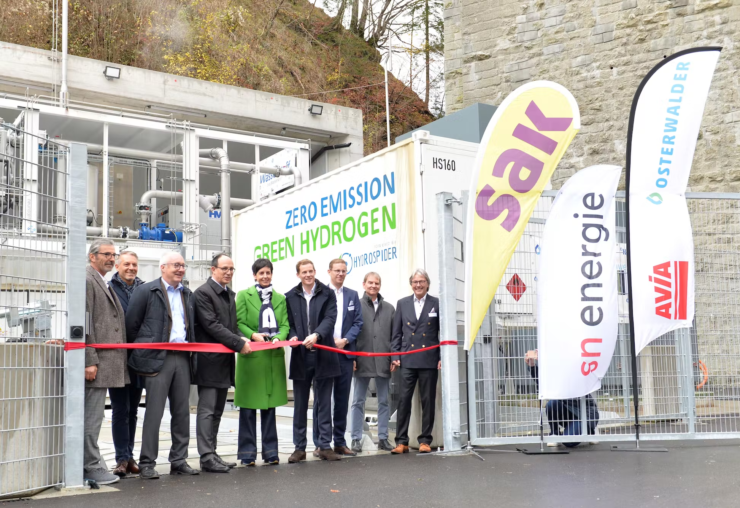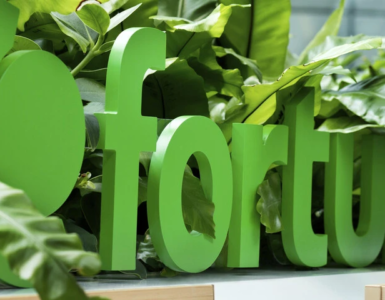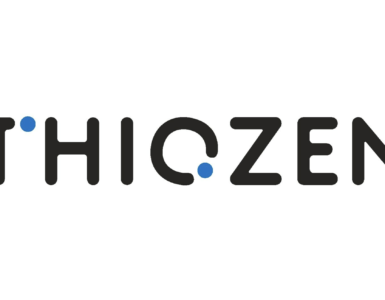Opening of the hydrogen production plant in the Kubel power plant.
A pioneering project becomes reality. Just over a year after the ground-breaking ceremony, the production of green hydrogen will start in the St. Gallen Kubel.
This is made possible by a unique, cross-sector cooperation between SAK (St.Gallisch-Appenzellische Kraftwerke AG), the Osterwalder Group and SN Erneuerbare Energie AG (SNEE), which are pooling their strengths and know-how in the joint venture Wasserstoffproduktion Ostschweiz AG (WPO).
Together with St. Gallen Vice President Marc Mächler and Susanne Hartmann, Member of the Cantonal Government and Head of the Construction Department of the Canton of St.Gallen, the stakeholders underlined the importance of green hydrogen for the energy transition, for the electromobility of the future and for the Canton of St.Gallen.
🔥 What about we co-host a webinar? Let's educate, captivate, and convert the hydrogen economy!
Hydrogen Central is the global go-to online magazine for the hydrogen economy, we can help you host impactful webinars that become a global reference on your topic and are an evergreen source of leads. Click here to request more details
The experts agree: Green hydrogen is one of the most important energy sources of the future for efficiently and safely storing electricity from renewable sources. With the opening of the production facility in Kubel in St.Gallen, the players are sending out an even stronger signal for the further expansion of a globally respected hydrogen ecosystem, which is already a reality in Switzerland.
The background: With the founding of Wasserstoffproduktion Ostschweiz AG in September 2019, SAK, the Osterwalder Group and, since July 2022, SN Erneuerbare Energie AG (SNEE) jointly invested in the construction of the Kubel production site in order to offer green hydrogen as renewable and clean energy for electromobility and for the decarbonisation of road transport.
14 months after the ground-breaking ceremony, the big moment of commissioning will follow on 17 November 2022.
The importance of this facility for the St.Gallen location was underlined, among others, by Marc Mächler, Vice President & Head of the Department of Finance of the Canton of St.Gallen, and Susanne Hartmann, Member of the Cantonal Government, Head of the Construction Department of the Canton of St.Gallen & Member of the Board of Directors of SAK.
Marc Mächler, St. Gallen Vice President said:
Hydrogen plays an important role in the conversion and expansion to renewable energies.
“It is therefore all the more gratifying that pioneering projects such as the Swiss hydrogen ecosystem are not only being planned, but also implemented. For the canton of St. Gallen, it is more than a signal. It is in the context of the numerous measures to promote renewable energies in all areas.”
Susanne Hartmann, Member of the Cantonal Government and Head of the Construction Department of the Canton of St.Gallen said:
Sun, wind and water provide renewable energies in abundance, but as a kind of ‘fresh product’ that has to be stored temporarily.
“With the use and expansion of renewable energies, as they are anchored in St. Gallen as priority planning for the years 2021 to 2031, we are also dependent on the possibility of storing and distributing energy. The implementation of this project makes a correspondingly important contribution to reducing the use of fossil fuels and thus also CO2 emissions in the Canton of St.Gallen.”
Milestone for the Swiss hydrogen ecosystem
For around two years, a globally respected hydrogen ecosystem has been emerging in Switzerland with the aim of implementing hydrogen electromobility and thus also the decarbonisation of road transport from source to consumer – from production and filling stations to passenger cars and heavy trucks that are already on Swiss roads.
With the commissioning of hydrogen production, SAK, as the operator of Switzerland’s oldest water storage power plant in the St.Gallen Kubel, is sending out a correspondingly important signal for the energy transition and the need to lead sustainable electricity production into the future.
Walter T. Vogel, Chairman of the Board of Directors of SAK, said:
The production of hydrogen optimally complements SAK’s portfolio.
“As an energy service provider for people in Eastern Switzerland, we are already committed to the expansion of hydroelectric and solar power as well as to the expansion of sustainable heat pump systems and e-mobility. With H2, we now also have an offer that supports the decarbonisation of heavy goods transport.”
Adriano Tramèr, Head of Production and Energy Solutions SAK:
SAK has been investing in future markets for the energy transition in Eastern Switzerland for many years.
“With the new hydrogen production plant in Kubel, we are turning our responsibility for the future of energy production and the energy transition into reality – today and not tomorrow. This pioneering role enables us to gain valuable practical experience for a promising energy source. However, the plant also demonstrates the innovative strength with which SAK makes renewable energies usable.”
The new production plant – one of the first in Switzerland – obtains electricity directly from the adjacent hydropower plant and thus produces CO2-neutral hydrogen from hydropower.
The electrolysis plant has a production rate of 36 kg of hydrogen per hour and an electrical output of 2 MW. Depending on how much electricity is available for H2 production, about 250 tons of green hydrogen are produced annually. This means that three to four hydrogen containers can be delivered daily to the Osterwalder Group’s filling stations and other locations.
Energy storage with green hydrogen
Green hydrogen offers great potential in the storage of renewable energies. This advantage enables hydrogen production in coordination with the feed-in into the SAK grid. In this way, hydrogen production also contributes to grid stabilization.
Renewable energies for the electromobility of today and tomorrow
The green hydrogen produced in the Kubel is used directly for passenger cars and heavy commercial vehicles with fuel cell drive. Hyundai Hydrogen Mobility (HHM) proves how reliably the latter are on the road in Switzerland with 47 XCIENT Fuel Cells (36-ton trailer trains) and more than 5 million kilometers covered in the past two years. Compared to diesel trucks, they saved more than 4,000 tons of CO2 emissions.
Martin Osterwalder, CEO of Wasserstoff-Produktion Ostschweiz AG and Co-CEO of the Osterwalder Group:
The power plant in Kubel enables the further expansion of the Swiss hydrogen ecosystem, with a local and very efficient cycle.
“We transport the green hydrogen with a container system ‘made in Switzerland’ to the two AVIA hydrogen filling stations in St. Gallen and Gossau, where the hydrogen vehicles refuel. For the Osterwalder Group, this is an important step towards supplying clean electricity exactly when customers need it in the new era of electromobility. With green hydrogen, this is already a reality today.”
In Switzerland, the Hydrospider in Niedergösgen and – now – the WPO in the St. Gallen Kubel are currently producing green hydrogen for use in electromobility. Thanks to the initiative of the H2 Mobility Switzerland association, fuel cell trucks and cars can already obtain green hydrogen from twelve public filling stations throughout the country.
The production volume in the Kubel offers capacities for around 3.5 million truck kilometers or up to 25 million kilometers with a hydrogen car. With the Hyundai NEXO and the Toyota Mirai, an SUV and a sedan with this form of electric drive are already available in Switzerland.
In addition, two other manufacturers, Opel and Renault (Hyvia), are about to introduce light commercial vehicles that are also powered by fuel cell electric drive.
Nationally anchored, internationally active
While a clean hydrogen ecosystem for mobility is being built in Switzerland on a private-sector basis, SNEE, as a 100% subsidiary of SN Energie AG and shareholder of Wasserstoff-Produktion Ostschweiz AG, opens up views far beyond the border.
Hans Hofstetter, Chairman of the Board of Directors of SNEE:
With our focus on renewable energy from wind and photovoltaics as well as power-to-X technologies, we count the production of green hydrogen among the key technologies for the energy transition.
“Also from a more global perspective, we see the opening of the production plant in Kubel as an important signal for all power plants to take this innovative path and to use the available natural energy sources more broadly. We know that nature offers energy in abundance. With the system in the Kubel, we can show how this power can be used and protected in equal measure.”
Opening of the hydrogen production plant at the Kubel power plant, November 17, 2022








